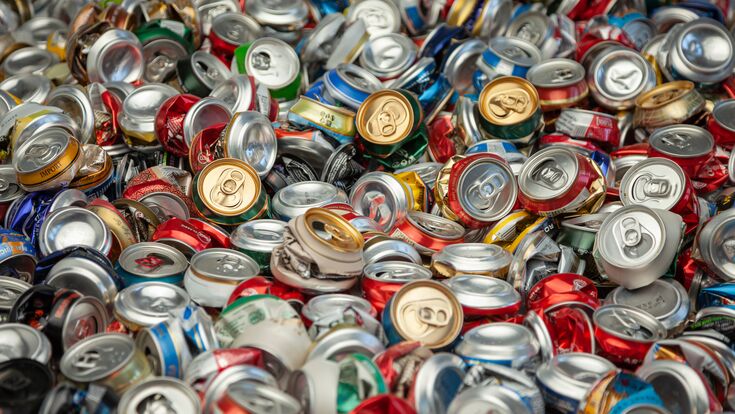Circular Economy : Aluminium recycling faces global strains despite economic and environmental promise

Aluminium is incredibly practical: it is corrosion-resistant, lightweight, easily deformable, non-magnetic, waterproof and odourless, conducts heat and electricity excellently, and, thanks to its harmlessness, is used in the food industry and everyday use in the kitchen. What is not so good, however, is the fact that the production of aluminium and its alloys is very energy-intensive. But this is where another property comes into play: aluminium can be recycled several times – without any loss of quality. Recycling aluminium is exceptionally energy-efficient, using just 5% of the energy required for primary aluminium production. According to the International Aluminium Institute (IAI), recycling a single aluminium can saves enough energy to charge up to 20 mobile phones. On a global scale, aluminium recycling conserves enough energy annually to power all of France. Additionally, recycling one tonne of aluminium prevents greenhouse gas emissions equivalent to driving 40,000 miles in an average U.S. vehicle. No wonder aluminium recycling plays a pivotal role in the global aluminium industry, offering substantial environmental and economic benefits.
Fostering aluminium recycling
Government policies – especially in the EU and North America – are pushing recycling rates higher with rules, incentives, and programmes that make producers more responsible for waste. Many European countries introduced DRS systems in recent years.
In many developed regions, like Europe and North America, recycling rates for packaging materials are already pretty high, often topping 60–70%. Strong collection systems, supportive regulations and consumer awareness all help keep things running smoothly.
On the other hand, many developing countries struggle with weak collection systems, informal recycling networks, and a lack of investment in better recycling technology. But things are starting to change, with more efforts to formalise the industry and boost recycling efficiency.
According to the IAI, Europe leads the world in aluminium recycling efficiency, recovering 81% of all available scrap in the region. Meanwhile, North America takes the top spot for recycling input, with 57% of the aluminium produced there coming from scrap. China, the biggest consumer of both new and recycled aluminium, also generates over 10 million tonnes of scrap aluminium annually – about a third of the global total.
A growing market
Data shows that the global aluminium recycling market is on the upswing. In 2023, it was valued at approximately USD 107.09 billion and is projected to grow to around USD 160.83 billion by 2032, with a Compound Annual Growth Rate (CAGR) of 4.62% during the forecast period.
In 2024, the global aluminium scrap recycling market processed roughly 38 million metric tonnes. This volume is expected to rise to 57 million metric tonnes by 2030, reflecting a CAGR of 7.0% from 2024 to 2030.
The aluminium recycling industry is – like many industries at the moment – undergoing a transformation, driven by technological advancements that are making the process more efficient and sustainable than ever before. Cutting-edge sorting and remelting technologies are significantly improving recovery rates and enhancing the purity of recycled aluminium. Modern recycling plants are embracing automation and energy-efficient methods, reducing waste and optimising production.
At the heart of this evolution is digitalisation. The integration of artificial intelligence (AI) and the Internet of Things (IoT) is revolutionising recycling operations, streamlining everything from material collection to quality control. These smart technologies are enabling more precise sorting, minimising contamination and maximising efficiency, ensuring that aluminium continues to be a cornerstone of the circular economy. As innovation accelerates, the industry is poised to set new benchmarks in sustainability and resource efficiency.
Challenges for the industry
But there are, of course, global developments threatening the industry. In February 2025, the U.S. imposed a 25% tariff on all aluminium imports, citing global overcapacity concerns. The tariffs had been paused later but as of April 2025, the United States has reinstated and expanded its tariffs on aluminum imports. Effective March 12, 2025, a 25% tariff applies universally to all aluminum imports, including derivative products, from all countries. While President Trump announced a 90-day pause on certain tariffs in early April 2025, this pause did not extend to the 25% tariffs on aluminum, steel, and automobiles. These specific tariffs remain active and are not subject to the temporary suspension.
This move has strained transatlantic trade, raising costs for U.S. importers and European exporters while offering little relief to the oversupply issue. The European Commission has voiced strong opposition and initially planned to impose retaliatory tariffs in response to the United States' reinstatement and expansion of 25% tariffs on steel and aluminum imports. However, following President Trump's announcement of a 90-day pause on certain tariffs, the EU decided to suspend its planned retaliatory measures for the same duration to facilitate negotiations.
Canada and China alas have imposed retaliatory tariffs.
Energy price volatility continues to threaten European aluminium production and recycling. Since 2021, electricity costs have surged by over 300%, now accounting for more than 80% of aluminium’s sale price. This sharp increase is putting pressure on producers, raising concerns about competitiveness and long-term sustainability.
As the industry deals with these challenges, changes in trade policies and a more stable energy market will be key to helping it stay strong.
Read our interview with Andy Doran, Director of Packaging, European Aluminium.


